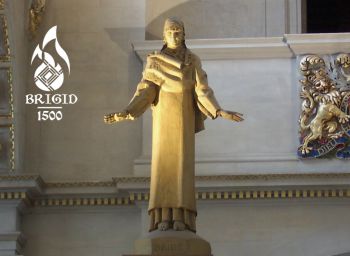It is rather nice to be able to put our very own patron saint St Bride – otherwise known as St Brigid of Kildare – centre stage this morning. Because, given the very special role that she ought to have in our lives, I can’t help feeling that she has, on occasions, remained somewhat in the shadows here.
For many years Guild Sunday has coincided with her feast day at the start of February – which is by no means inappropriate, of course – given that it is a Guild that bears her name; but inevitably those Sundays have sometimes ended up focussing rather more on the Guild than on the saint.
And if you look around our wonderful church today, there are relatively few places where she features in our art and imagery. Most obviously, of course, we have a splendid statue of her up above me there, looking down upon the nave … where she can be spotted by those visitors who happen to raise their eyes heavenwards. And there are other Brigid-related symbols, too, of which I shall say more in a moment – but sometimes you have to look very closely to find them.
There are several reasons why it feels very timely for us to be giving St Bride a much higher profile within our life here, in this church that bears that is dedicated in her name and to her memory. But before I say any more about that, what do we know about her?
For any of you who are unfamiliar with her story, Bride – Brigid – who is the patroness (or mother saint) of Ireland, is said to have been born in the late fifth century, just outside Kildare. As with many of the ancient Celtic saints it is almost impossible to disentangle historical fact from mythology and folk tale where her story is concerned – and the fact that she happens to share the name of a Celtic pagan goddess complicates things further.
Nevertheless, the story goes that Bride was a rich man’s daughter, who gave away her father’s wealth to beggars, much to his annoyance, because it was without his consent. Tradition has it that she was baptized by St Patrick, and that she went on to embrace the religious life, founding several abbeys, most famously the one at Kildare. She was a woman of profound compassion, whose hospitality was, quite literally, the stuff of legend. This included her alleged ability to turn bathwater into beer when unexpected visitors showed up (who I am sure were as appreciative as they were bemused by this remarkable feat). You have got to love a patron saint who can pull that one off!
And like many of the Celtic saints, Brigid was said to have had a particular affinity with the natural world. I have often noticed this amongst holy men and women of all faith traditions, and certainly those within the Christian fold. When I was for many years chaplain to the Community of St John the Divine in Birmingham, I was often struck by how attentive some of the sisters could be to the things around them: to people and situations, but also to the simple wonders of creation. When I first joined them, one of the most frail and elderly of the sisters always carried a magnifying glass with her, in case she found an insect or a leaf, or something else of interest to look at closely in the convent garden. Her sense of respect and wonder, and her capacity to treasure even the most insignificant and miniscule parts of God’s creation – things that I myself would have completely overlooked – always reminded me of how unobservant I am, and how readily I take for granted the wonders of the natural world.
St Brigid’s sixth century biographer, Cogitosus, wrote this:
Holy Brigid, whom God had chosen beforehand to be conformed and predestined to his image, was born of noble Christian parents. As the chosen of God, she was indeed a girl of great modesty, who as she grew in years grew also in serenity.
Once a wild boar that was being hunted charged out of the forest, and in the course of its panicking flight careered into a herd of pigs that belonged to the most Blessed Brigid. She noticed its presence and blessed it. Immediately the creature lost its sense of fear and settled down quietly among the herd of pigs. See, my friends, how even the wild beasts could not resist either her bidding or her will, but served her docilely and humbly.
… from these and many other episodes which demonstrated her power, it is certain that blessed Brigid could command the affection of wild animals, cattle and the birds of the air.
I mentioned that there are other symbols of St Brigid in our church, which can easily be overlooked. One of them is on the front of the lectern at which I am now standing, which displays the image of a ring of fire. That same symbol appears around the perimeter of the medallions worn by members of the Guild of St Bride, which has at its centre a Celtic Cross, another reminder of our Irish heritage.
And the reason for this fire symbolism? It is said that in pagan times in Kildare, a ritual fire was kept permanently alight, to invoke protection on cattle and the harvest. When St Brigid built her abbey, she continued the custom of keeping this fire alive, but as a symbol of the light of Christ, which no amount of darkness can ever extinguish. When our mediaeval Guild of St Bride was founded in the fourteenth century, part of its original purpose was to keep a light permanently shining before the statue of St Brigid.
As many of you will know, we reconnected with this mediaeval tradition at the start of the first lockdown in 2020 when, our doors having had to close, we kept a candle burning in church each day. And we have continued that tradition: it is the light that is currently standing in the centre of the altar behind me. Not only does it realign us with the story of the perpetual fire of Brigid, but, for me, it also encapsulates our task here today: to strive to keep alive the flame of faith in this holy place, and to ensure that the perpetual light of Christ continues to burn for each new generation. And in so doing, to inspire others to seek that light, and to hear Christ’s call.
Another symbol of St Brigid that you can see downstairs in our crypt chapel, is the distinctive cross of St Brigid. I have one with me here, and we have another one on the front of our altar today. Typically it is a small cross that is woven from rushes, with four arms and a square in the middle – and traditionally in Ireland they were woven on 1st – St Brigid’s day. It became common practice to set small Brigid crosses over doorways, to protect the home from harm.
Like so much about St Brigid, it is likely that her woven cross also has pre-Christian origins – and yet, there is a specifically Christian story behind it, too. The story goes that Brigid was attending to an elderly dying man in his home, the floor of which was strewn with rushes. She picked up some rushes from the floor and began to weave them into a cross. Intrigued, the man asked her what she was doing, and she spoke to him about the Cross of Christ that it symbolised and about God’s love and grace and forgiveness of Christ. He then asked for baptism on his death bed.
Fact and folk tale are closely woven together in the story of St Bride. Does that matter? Throughout the whole of human history, people of all cultures and backgrounds have used story as the principal way in which to communicate the most profound truths of human existence across the generations. That is why Jesus himself delivered so much of his own teaching in the form of parables – which are stories that encapsulate and deliver challenging and uncomfortable truths: it is left up to us whether we are able to hear those truths and act upon them.
And now think about the themes and associations that are woven through the story of our wonderful patron saint: her profound compassion for the poor and the needy and the dying. Her readiness to give up her privileged life and her freedom in the service of Christ, and to do so in a hostile pagan environment. Her generous hospitality and ministry of welcome. Her love and respect for Creation and the natural world. Her determination to keep the light of Christ permanently afire, that others, too, might come to know the brightness of that perpetual light. Her inspiration to those who followed her, who travelled across Europe taking Christ’s message of new life and new hope and new freedom with them. At some point during the sixth century, some of them found their way to this place, just outside the walls of the Roman city Londinium. Which is why we are gathered here today.
What better inspiration could we have to remind us of our own calling and true priorities as a community of faith … than the example of that remarkable fifth century Irish woman who gave her name to the amazing holy place that we see around us today.
Amen.



